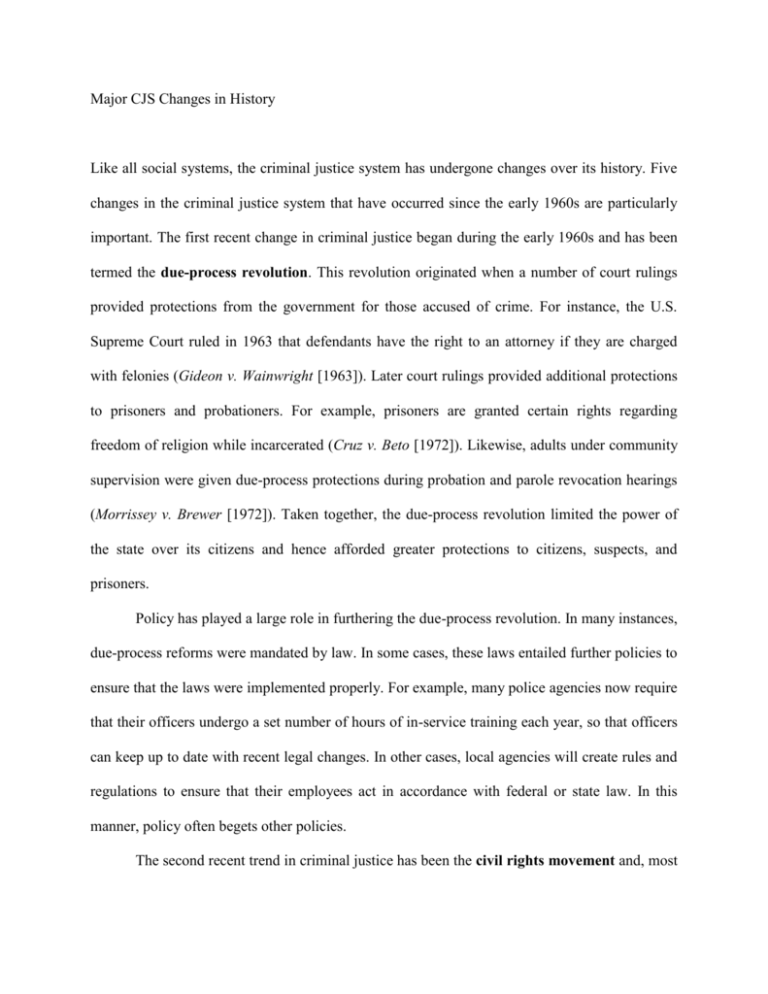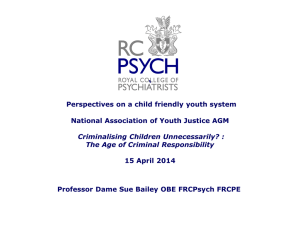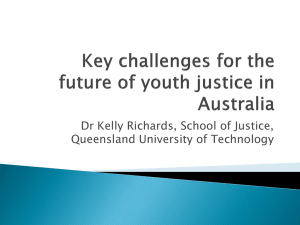Major CJS Changes in History
advertisement

Major CJS Changes in History Like all social systems, the criminal justice system has undergone changes over its history. Five changes in the criminal justice system that have occurred since the early 1960s are particularly important. The first recent change in criminal justice began during the early 1960s and has been termed the due-process revolution. This revolution originated when a number of court rulings provided protections from the government for those accused of crime. For instance, the U.S. Supreme Court ruled in 1963 that defendants have the right to an attorney if they are charged with felonies (Gideon v. Wainwright [1963]). Later court rulings provided additional protections to prisoners and probationers. For example, prisoners are granted certain rights regarding freedom of religion while incarcerated (Cruz v. Beto [1972]). Likewise, adults under community supervision were given due-process protections during probation and parole revocation hearings (Morrissey v. Brewer [1972]). Taken together, the due-process revolution limited the power of the state over its citizens and hence afforded greater protections to citizens, suspects, and prisoners. Policy has played a large role in furthering the due-process revolution. In many instances, due-process reforms were mandated by law. In some cases, these laws entailed further policies to ensure that the laws were implemented properly. For example, many police agencies now require that their officers undergo a set number of hours of in-service training each year, so that officers can keep up to date with recent legal changes. In other cases, local agencies will create rules and regulations to ensure that their employees act in accordance with federal or state law. In this manner, policy often begets other policies. The second recent trend in criminal justice has been the civil rights movement and, most importantly, the increased representation of people of color and women as criminal justice employees. Historically, even until the late 1960s, criminal justice employees have almost always been white males. As the civil rights movement gained momentum in the United States during the 1960s, the system began to open employment opportunities to people of color. For example, many city police agencies began actively recruiting blacks as police officers during the mid- and late 1960s. Likewise, prisons and probation and parole departments also recruited and hired people of color in attempts to make the employees of the system more representative of the country’s population. The employment of women as system employees followed a similar trend, beginning in the late 1960s. The increased representation of people of color and women as system employees is, however, a relatively recent trend, and it is due in large part to the broader civil rights movement. This second trend also entailed a range of new policies. Some agencies had implemented minimum educational requirements that inadvertently discriminated against hiring people of color. Likewise, some agencies had minimum height and weight requirements for employees, requirements that deterred the employment of women. New policies had to be created to mend these problems and open the field up to a more diversified range of potential employees. Further, once hired, women had to be provided with specific accommodations, such as their own locker rooms and uniforms, and new policies on harassment and maternity leave were created. Again, larger social trends have influenced trends in the system, which in turn has required the creation of new policies. The third recent trend in criminal justice has been the inclusion of community in many facets of the system. Since the mid- and late 1980s, various aspects of the system have sought to include the views, opinions, inputs, and even assistance of local community members. Such was not always the case. These criminal justice innovations include community policing, changes in community corrections, and the creation of specialized courts, such as drug courts. Even various alternatives to traditional courts, such as mediation and restorative justice, can be included here, for they all change the role that community members and victims play in criminal justice processes. Each of these community-oriented changes has sought to include victims and community residents in order to tailor local criminal justice responses to each locale. As one might expect, the increasing inclusion of community influences in the system has led to new policies. These new policies have helped create new arrangements and relationships between the system and communities. For instance, many jurisdictions now have arrangements between their local courts and local service providers, such as community centers, homeless shelters, and substance abuse clinics, where defendants in need of services are referred. In some cases, such referrals are part of the defendants’ formal disposition, and this entails new policies to formalize such arrangements. Further, new policies have also delineated the boundaries between communities and the system. For example, halfway houses often have policies as to who can be placed there, the conditions the residents must abide by in order to remain, and how rule violations are handled. The fourth recent trend in criminal justice has been a move toward increasing punitiveness in the system. This trend has been evident since the 1970s and has affected all aspects of the system. For instance, mandatory arrest laws reflect a more punitive attitude toward domestic violence offenders. In addition, some states have abolished plea bargains in an effort to prevent lenient punishment of offenders. Finally, many states have adopted mandatory sentencing policies that keep certain offenders locked up in prison for an extended period of time. These punitive policies have resulted in an increase in the number of offenders in the criminal justice system. This is evident in the dramatic increase in the incarceration rate over the past 25 years. In fact, in 2010 the United States has the highest incarceration rate of any Western country—734 inmates per 100,000 population (adapted from Sourcebook, 2010: Table 6.1.2010). The increase in punitiveness may satisfy retributivists, who feel that punishments must fit the crime and that offenders must pay for their deeds. It may also satisfy those who agree with the incapacitation philosophy of punishment—if offenders are kept away from society, they cannot harm it. It remains to be seen, however, if increased punitiveness has had an effect on deterrence, as many studies show that increased punishment does not necessarily deter crime (see Blumstein, Cohen, and Nagin 1978). The fifth recent trend has been the effects of September 11th on the criminal justice system. In many ways these effects have only begun to run their course and it is not clear what their final results will be on how the criminal justice system operates. At this point it is clear, however, that the system in many places is responding to the threat of future terrorist attacks. For police, the expectation is that local law enforcement will play a crucial role in uncovering and preventing future terrorist attacks, in collaboration with federal agencies. For most agencies this involves gathering information from the community, something most police agencies already attend to each day. Federal law enforcement agencies play a role. For example, the FBI coordinates the terrorist prevention activities of some local law enforcement, especially through its Joint Terrorism Task Forces, but the FBI lacks the manpower to field sufficient eyes and ears across the United States. In 2005, The FBI had 2,196 agents devoted to anti-terrorism, while local law enforcement agencies fielded more than 700,000 officers (Maguire and King 2009). Local law enforcement personnel will play a crucial role in information gathering for the foreseeable future. Some agencies have established formal, systematic ways to enlist the help of local citizens in preventing future terrorist attacks. For example, the Washington, DC Metropolitan Police Department created a program to educate the public about suspicious behavior that might be associated with a terrorist group and urged the public to call a hotline for gathering these tips (http://mpdc.dc.gov/page/operation-tipp). Such efforts in the United States mirror recent developments in policing in the United Kingdom (Innes 2006). The court system has also been influenced by the focus on terrorism since September 11, 2001. At the federal level, federal prosecutors have increased the percentage of terrorist cases they choose to prosecute, but as of 2002 they still declined to prosecute approximately half of all terrorist cases brought before them (TRAC Reports 2002). Prior to September 11, 2001, federal prosecutors were most likely to prosecute suspected terrorists for relatively common offenses (such as racketeering and firearms offenses) and not for terrorism (Smith and Orvis 1993). Other thorny legal issues involve the rights of individuals detained overseas on suspicion of terrorism, the legal limits of interrogation techniques, and the proper venue for detainee trials. These issues will be revisited in the years to come, as America responds to future terrorist threats.








